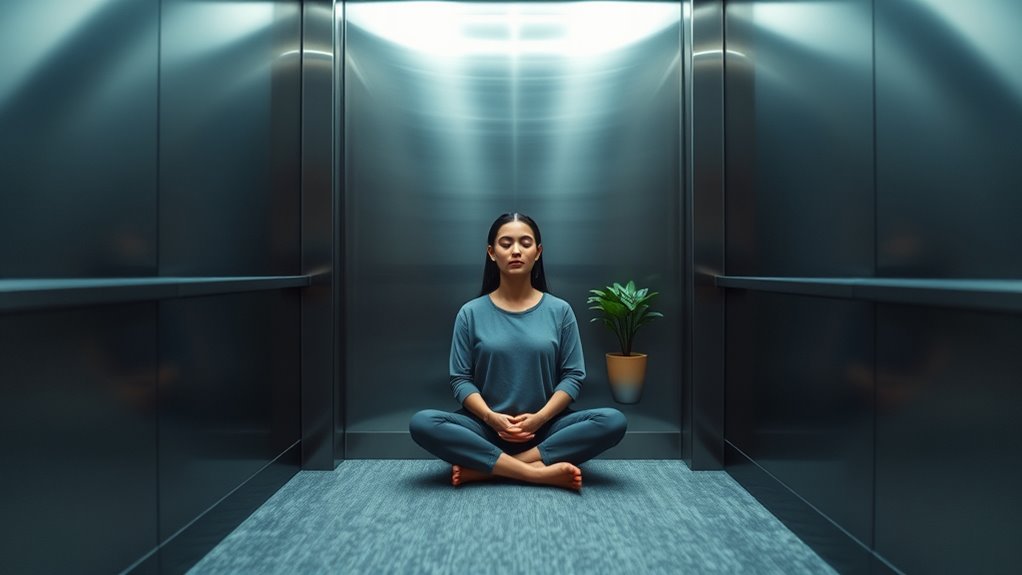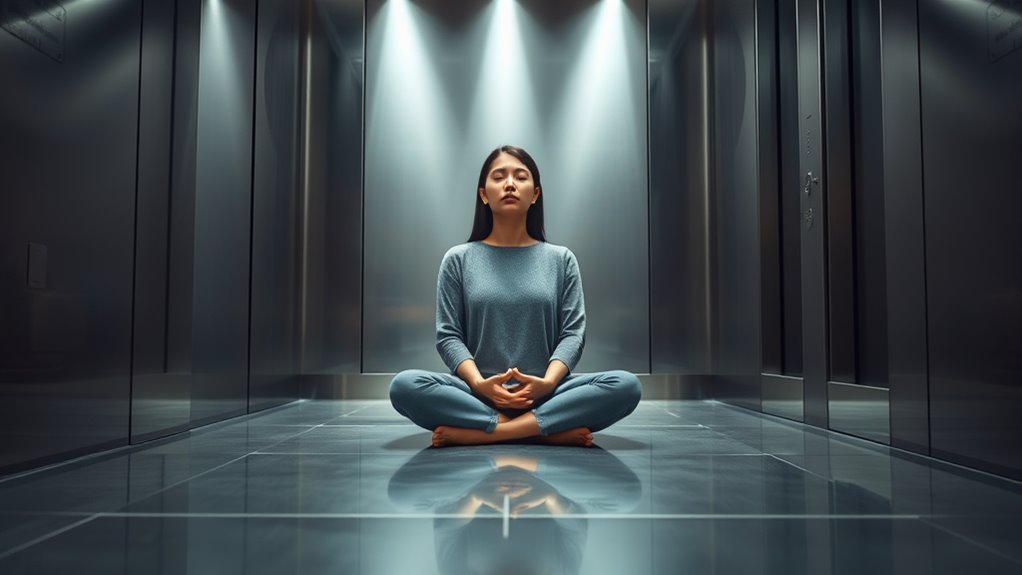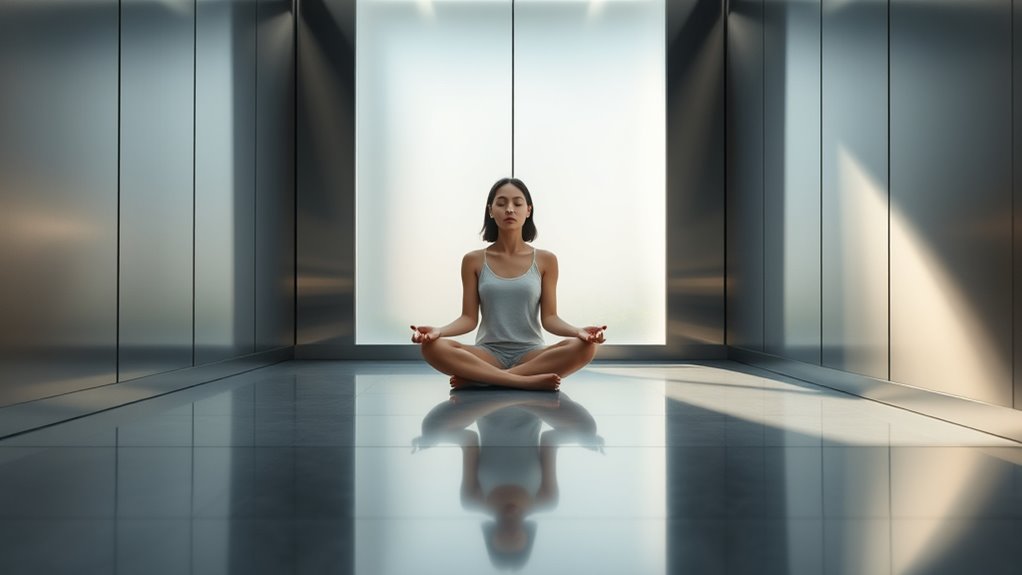In an elevator, you can practice a quick micro-meditation by focusing on your breath—inhale slowly through your nose, exhale gently through your mouth—to calm your mind. Pay attention to sensory cues like sounds, textures, or ambient smells to ground yourself in the present. Adjust your posture to stay relaxed and supported. With a few mindful moments, you set a peaceful tone for your day. If you’re curious, you’ll discover more simple techniques to stay centered during brief pauses.
Key Takeaways
- Focus on deep, slow breaths to anchor your mind and promote calm during the elevator ride.
- Use sensory awareness by noticing textures, sounds, and smells to deepen mindfulness in confined spaces.
- Maintain a relaxed, upright posture, adjusting as needed for comfort and stability.
- Visualize a peaceful place or silently repeat calming phrases to reduce stress and enhance focus.
- Set a mental intention for the ride, such as relaxation or clarity, to create a purposeful micro-meditation.
Preparing Your Mind for a Moment of Calm

Before stepping into the elevator, take a moment to center yourself. Use simple mindfulness techniques like deep breathing or grounding your attention on your senses. Focus on your breath—inhale slowly through your nose, then exhale gently through your mouth. This helps you stay present and reduces anxiety about the upcoming ride. Visualize a peaceful place or repeat a calming phrase silently. These small actions promote stress reduction and prepare your mind for a brief moment of calm. By intentionally setting your intention before entering, you create a mental space that makes it easier to relax during the elevator ride. Using mental clarity techniques can further enhance your sense of control and confidence. Developing color accuracy awareness during your mindfulness practice can help you better interpret visual cues and stay centered. This quick mental prep helps you stay centered amidst daily stressors, turning a fleeting moment into an opportunity for mindfulness.
Finding Your Comfortable Position

Start by finding a posture that feels supported and steady, allowing your body to relax. Adjust your seat or stance until you’re comfortable, without strain. When you’re supported and at ease, it’s easier to focus on your breath and stay present. Incorporating mindfulness techniques can deepen your relaxation during this micro-meditation. Ensuring your position is stable also helps prevent discomfort from poor posture, enabling you to maintain focus longer. Using proper body alignment can further enhance your comfort and meditation experience, especially when you are mindful of your ergonomic setup to promote better support.
Find a Supportive Posture
Finding a supportive posture is essential to making micro-meditation in elevators effective. When you sit or stand with proper posture alignment, it becomes easier to cultivate mindful awareness of your body and breath. Keep your spine straight but relaxed, allowing energy to flow freely. Ground your feet firmly if standing, or sit with your back supported if possible. Avoid slouching or leaning heavily on one side, as this can create tension. A balanced, upright position helps you stay present and centered, even in a confined space. Focus on the way your body feels in this supportive posture, noticing any areas of tension or ease. Incorporating body awareness techniques can deepen your mindfulness practice in such small, everyday moments. Maintaining proper posture alignment can also prevent discomfort during longer periods of micro-meditation. Additionally, paying attention to ergonomic benefits ensures you sustain comfort and avoid strain during your practice. Being aware of neurological aspects of dreaming can also help you recognize the importance of relaxation and proper posture in achieving a calm state conducive to meditation.
Adjust for Comfort
Once you’ve established a supportive posture, the next step is to adjust your position for maximum comfort. This allows you to deepen your mindful awareness and enhance sensory grounding. Sit or stand in a way that feels natural, relieving tension in your body. Make small adjustments to your feet, back, or shoulders to find your ideal position. Focus on how your body feels in this moment, noticing areas of tension or ease. Remember, comfort is key to maintaining presence and avoiding distraction. Paying attention to your body’s signals can help you manage stress effectively and stay centered during your meditation. Relax your shoulders and jaw to release unnecessary tension. Confirm your feet are flat and grounded for stability. Keep your spine aligned but not rigid for ease of breathing. Incorporating awareness of your body’s sensations can further support your relaxation and mindfulness. Being mindful of your physical comfort can help you sustain your practice and deepen your relaxation. Additionally, being aware of your emotional state can enhance your overall sense of well-being during meditation.
Focusing on Your Breath

Focusing on your breath is a simple but powerful way to anchor your mind during a micro-meditation in an elevator. By practicing breath awareness, you can instantly center yourself amid busy surroundings. Take a deep breath, feeling the air fill your lungs, then slowly exhale. Notice the sensation of each inhale and exhale, letting your mind settle into this rhythm. This mindfulness practice helps reduce stress and brings clarity. To evoke emotion, consider this:
| Calm | Stress | Focus |
|---|---|---|
| Serenity | Tension | Clarity |
| Ease | Anxiety | Presence |
| Balance | Overwhelm | Awareness |
Focusing on your breath transforms a fleeting moment into a mindful pause, helping you find calm wherever you are. Practicing this during a micro-meditation can enhance your overall well-being and resilience during daily challenges. Incorporating mindfulness techniques like breath awareness can also support your ability to remain calm during high-pressure situations, such as navigating busy environments or making quick decisions. Recognizing the Italian cultural emphasis on slow living can deepen your appreciation for these mindful moments and foster a greater sense of balance in everyday life. Additionally, understanding the variety of dog names can inspire creative ways to personalize your own mindfulness practice or pet care routines.
Engaging Your Senses

As you settle into the elevator, shift your attention beyond your breath and start engaging your senses. Focus on what you can see, hear, and feel around you. This practice enhances sensory awareness and activates mindfulness triggers that ground you in the present moment. Notice the textures of your clothing or the coolness of the elevator walls. Observe the sounds—beeping, footsteps, distant chatter—and let them anchor you. Pay attention to the subtle smells or temperature shifts. By actively engaging your senses, you create a simple but powerful anchor to the here and now. Incorporate mindfulness techniques into your routine to deepen your connection to the present. This brief focus can transform a mundane elevator ride into a moment of mindful connection and calm. Recognizing sensory engagement as a key mindfulness strategy can amplify your ability to stay centered throughout the day. Developing awareness of your aura colors can further enhance your self-understanding and spiritual growth. Exploring fatherhood quotes can serve as an inspiring reminder of the importance of guidance and support in your life and the lives of others. Use these sensory cues to deepen your awareness and cultivate stillness amid everyday activity.
Returning to Your Day With Intention

After your brief moment of mindfulness in the elevator, take an intentional moment to set your direction for the rest of your day. Use this time to reconnect with mindful awareness, acknowledging how you feel and what you need. Focus on your breath or a simple intention—whether it’s staying calm, productive, or compassionate. By consciously choosing your mindset, you bring intentional presence into your actions and interactions. This small act helps you *segue* smoothly from a brief pause to full engagement with your day. When you return to your tasks, you’ll do so with clarity and purpose, grounded in awareness. Incorporating mental and emotional well-being techniques can amplify the benefits of this practice, supporting a more balanced and positive mindset throughout your day. This intentional shift can transform routine moments into opportunities for focus and positivity.
Making Micro-Meditation a Daily Habit

Incorporating micro-meditation into your daily routine requires intentional effort but offers lasting benefits for your well-being. To make it a habit, focus on consistent practice and mindful repetition. Set aside specific times during your day—like during elevator rides or breaks—to engage in these quick meditations. Over time, these small moments become automatic, helping you stay grounded amidst a busy schedule. Remember, the key is regularity; even a minute or two daily can make a difference. Establish a specific cue to trigger your micro-meditation and keep reminders visible to reinforce the habit. Be patient—habit formation takes time but pays off in reduced stress and increased clarity. Additionally, using eye patches during your routine can help refresh your eyes and promote relaxation, supporting your overall well-being. Practicing mindfulness consistently can further enhance your ability to maintain this beneficial practice, similar to how targeted auditory processing techniques improve communication skills over time.
Frequently Asked Questions
Can Micro-Meditation Help Reduce Elevator Anxiety?
Micro-meditation can definitely help reduce elevator anxiety by promoting stress reduction and relaxation. When you feel nervous, taking a few deep breaths or focusing on your senses helps calm your mind. These quick relaxation techniques are easy to do anywhere, including in an elevator. Regular practice can make you more resilient to anxiety triggers, so you feel more in control and relaxed during your elevator rides.
How Long Should Each Elevator Micro-Meditation Last?
Ever wonder how long your quick mental reset should last? The key is simplicity—aim for a meditation duration of just 30 seconds to a minute. Timing guidelines suggest keeping it brief yet effective, so you can carry on with your day feeling refreshed. In tight spaces like an elevator, this short burst works wonders, helping you stay calm and centered without missing a beat.
Is Micro-Meditation Suitable for Beginners With No Meditation Experience?
Micro-meditation is perfect for mindfulness beginners because it’s simple and accessible. You don’t need prior experience or special equipment, making meditation accessible to everyone. Even if you’re new, you can quickly learn to focus on your breath or sensations, fitting into busy schedules like riding an elevator. It’s a practical way to start building a meditation habit, helping you experience calm and clarity anytime, anywhere.
What if I Forget to Focus During the Micro-Meditation?
Think of your mind as a busy street—you might get distracted along the way. If you forget to focus during your micro-meditation, don’t worry. Use mindfulness reminders or focus techniques to gently steer your attention back. It’s like catching a falling leaf; each time you refocus, you strengthen your mindfulness muscles. With practice, returning to your breath or sensation becomes second nature, making each session more effective.
Can Micro-Meditation Replace Longer Meditation Sessions?
Micro-meditation can complement but not fully replace longer meditation sessions. While it enhances your mindfulness techniques and offers quick mental resets, it’s limited in meditation duration and depth. If you’re seeking profound relaxation or deep focus, longer sessions are more effective. Think of micro-meditation as a handy tool for busy moments, but don’t rely solely on it for all-encompassing mindfulness practice. Balance both for best results.
Conclusion
So, next time you’re stuck in an elevator, don’t just stare at the buttons—take a moment to breathe and relax. It’s ironic how a tiny pause in a tiny space can transform your whole day. Who knew that a few seconds of micro-meditation could turn an awkward elevator ride into your personal oasis? So go ahead, embrace the irony—your busy schedule might just thank you for it.









